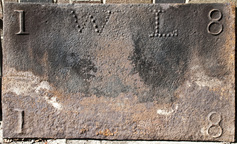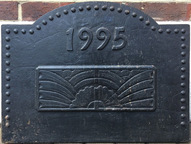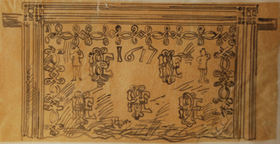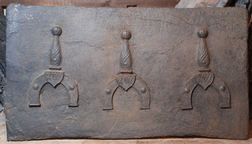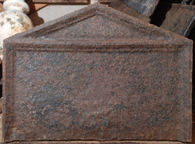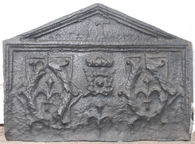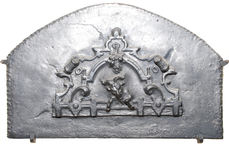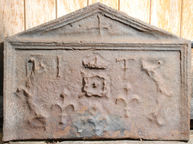-
1299
Description: Rectangular shape without edging; date in an elegant Roman style split between top and bottom corners; top centre, beaded initials WL.
Notes: The dotted initials are unusual, in all probabiltiy the dots being individually pressed into the moulding sand.
Inscription: I W L 8 / 1 8
- Decoration tags:
- rectangular (shape)
- none (edging)
- simple stamps
- carved stamps
- individual letters
- individual numbers
- text
Manufactured: in 1818 in England.
Current location: in private hands, Chiddingly, East Sussex, England.
- Attached to series:
- Date & initials firebacks
-
1266
Description: Arched rectangular shape; plain edge with 49 large beads parallel with top and sides; upper centre, date in bold Arabic numerals; below date, raised rectangular panel with chamfered sides and corners and fillet edging, and a symmetrical sunburst and rainbow design in low relief.
Notes: Modern, quasi-Art Deco design
Inscription: 1995
- Decoration tags:
- rectangular with round arch (shape)
- none (edging)
- whole carved pattern
- individual numbers
- text
- objects
Manufactured: in 1995 in England.
Current location: in private hands Croydon, Greater London, England.
- Attached to series:
- Miscellaneous pattern firebacks
- 1990s Art Deco series
-
949
Description: Rectangular; low-relief moulded edging along top, then down sides; double-looped 'lens' pattern stamp repeated six times across the top, inside the edging and, rotated, three times down each side; becapped human figure stamp, with his left arm raised to his head and his right arm akimbo, repeated in each top corner; between these, 'IE' monogram with continuous loop between the letters repeated five times, two in line above and three below, the centre one slightly raised; the date between the top two; a lifting handle on each side.
Notes: Said to have been at Horsham, Sussex; on another fireback, at the Old Manor, Upper Beeding in Sussex, cast with the same stamps, and also dated 1617, the monogram stamp is clearly carved on a 'renaissance' shield, indicating that in this instance the stamps were not impressed as deeply. Drawing by J. Lewis André in the J. Starkie Gardner Collection, Victoria & Albert Museum, Archive of Art and Design (AAD/2014/8). Possibly the fireback referred to by Lewis André in 1882 as belonging to a Miss Alman, of East Street, Horsham (Sussex Archaeological Collections XXXII, p.76).
Inscription: IE 1617 IE / IE IE IE
- Decoration tags:
- rectangular (shape)
- complex individual (edging)
- carved stamps
- individual numbers
- lifting handles
- monogram
- text
- humans
Manufactured: in 1617 in the Weald area of England.
Current location: not known.
Citation: Gardner, J. S., 1898, 'Iron Casting in the Weald', Archaeologia, 56, 1, pp. 133-164.
Citation: Gardner, J. S., 30 Apr 1904, 'An old fire-back' (letter), Country Life, p. 647.
-
166
Description: Rectangular; plain plate with three stamps of an iron firedog with a twisted design on the neck, a primitive face on the terminal and a shield bearing initials RW.
Notes: The letters RW are said to relate to Richard Woodman, ironmaster and Protestant martyr, who resided at Cralle Place, and who operated Cralle furnace. A near-identical firedog was discovered at Bridge Cottage, Uckfield, Sussex.
Inscription: RW
- Decoration tags:
- rectangular (shape)
- none (edging)
- simple stamps
- objects
Manufactured: in the mid-16th century probably at Cralle Furnace, Warbleton in the Weald area of England.
Current location: Hastings Museum and Art Gallery, John's Place, Bohemia Road, Hastings, East Sussex, England.
Museum number: HASMG: 1909.94 (part of the Hastings Museum museum group)
Citation: Butterfield, W. R., 1916, 'Old Wealden Firebacks', The Connoisseur, 46, pp. 197-209.
- Attached to series:
- Firedog stamp firebacks
- Metalware stamp firebacks
-
186
Description: Plain rectangle with cavetto moulded edging (top and sides); pediment with same moulding.
Notes: Three identical backs, but with various stamps, indicate that the pattern for this fireback formed the base board for them and came from the same source as a distinct series of Tudor heraldic backs. Formerly part of the Ade Collection (from Grove Hill, Hellingly, Sussex).
- Decoration tags:
- triangular arched (shape)
- cavetto (edging)
Manufactured: in the mid- to late-16th century in the Weald area of England.
Current location: Hastings Museum and Art Gallery, John's Place, Bohemia Road, Hastings, East Sussex, England.
Museum number: HASMG: 1952.51.47 (part of the Hastings Museum museum group)
- Attached to series:
- Royal series
- Base boards
- Royal (wreath) series
-
338
Description: Rectangular with pediment; ovolo moulded edging inside top of pediment and inside top and sides of rectangle; centre top, four-petal rose and crown with fleur de lys below; at either end, stamps made from two parts of a wreath (the middle section missing) enclosing a fleur de lys.
Notes: The wreaths from which the stamps have been disassembled can be seen complete on two other firebacks, and the rose and crown is a common stamp on a large series of early firebacks.
Inscription: ?I T
- Decoration tags:
- triangular arched (shape)
- ovolo (edging)
- carved stamps
- individual letters
- heraldic
- text
- objects
Manufactured: in the late-16th century in the Weald area of England.
Current location: in private hands Burford, Oxfordshire, England.
- Attached to series:
- Royal series
- Royal (wreath) series
- Fleur-de-lys firebacks
-
375
Description: Rectangular; twisted rope edging (top and sides); central rope carbuncle with eight arms, with a rose between each of the top six pairs of arms; a fleur-de-lys repeated six times in two triads (2-1) in each top corner; a letter ‘E’ rotated clockwise repeated 8 times along the top between the fleurs and roses, and twice down each side; four additional ‘E’s, one to the left of the carbuncle and three to the right.
Notes: All the stamps can be seen on other firebacks associating them with the same source; The ‘E’s are identical to those seen on the John Harvo armorial fireback. The elaborate central rope array may be an interpretation of the escarbuncle, which was the principal heraldic charge on the arms of the Duchy of Cleves, possibly associating this fireback with the brief marriage of Henry VIII and Anne of Cleves. Formerly part of the J. H. Every collection.
- Decoration tags:
- rectangular (shape)
- rope (edging)
- simple stamps
- carved stamps
- heraldic
- text
- objects
Manufactured: in the mid- to late-16th century possibly at Pounsley Furnace, Framfield in the Weald area of England.
Current location: Anne of Cleves House, Southover High Street, Lewes, East Sussex, England.
Museum number: 1944.24.076 (part of the Sussex Archaeological Society museum group)
Citation: Hughes, G. B., 1960, Collecting Antiques (London, Country Life), pp. 85-93.
Citation: Hughes, G. B., May 1940, 'Old English Firebacks', Apollo, 31, 185, pp. 117-120.
- Attached to series:
- Pounsley series
- Fleur-de-lys firebacks
-
559
Description: Arched rectangle with crude scalloping around the edges; elaborate, symmetrical strapwork frame with scrolls top left and right, and below, a bunch of grapes hanging from the top, and the head and forelegs of a goat climbing through; inside each upper scroll, a small astragel edged oval.
Notes: This strap-work stamp, characteristic of late-16th and early-17th century architectural drawings and engravings and derivative of the work of artists like Hans Vredeman de Vries, was probably derived from interior carving on a fireplace overmantel or similar. The goat and bunch of grapes suggest an allusion to Bacchus. Marks round the edge of this fireback suggest that it may have been reduced from a larger size. Mitford collection, Petworth House.
- Decoration tags:
- rounded arched (shape)
- scalloped (edging)
- simple stamps
- architectural
- animals
- plants
- objects
Manufactured: in the late-16th to early-17th century possibly in the Weald area of England.
Current location: Petworth House, Petworth, West Sussex, England.
Museum number: NT/PET/M/53 (part of the National Trust museum group)
- Attached to series:
- Miscellaneous stamp firebacks
-
689
Description: Rectangular with pediment; ovolo moulded edging inside top of pediment and inside top and sides of rectangle; centre top, four-petal rose and crown with three fleurs-de-lys below; at either end, stamps made from two parts of a wreath (the middle section missing); in the pediment a cross.
Notes: The wreaths from which the stamps have been disassembled can be seen complete on two other firebacks, and the rose and crown is a common stamp on a large series of early firebacks.
Inscription: I T
- Decoration tags:
- triangular arched (shape)
- cavetto (edging)
- carved stamps
- individual letters
- heraldic
- royal
- text
- objects
Manufactured: in the late-16th century in the Weald area of England.
Current location: in private hands, Slaugham, West Sussex, England.
- Attached to series:
- Royal series
- Royal (wreath) series
- Fleur-de-lys firebacks
